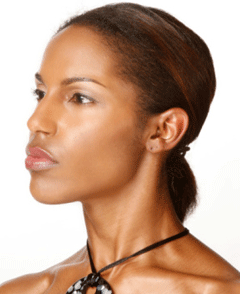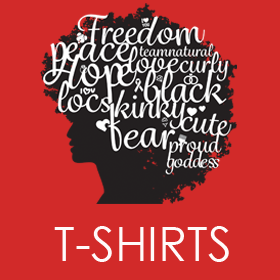 Here are some tips I can share to help you keep breakage to a minimum…
Here are some tips I can share to help you keep breakage to a minimum…
1. Keep Your Hair Moisturized From Root to Tip
When I first started transitioning (months 2-4), I was trying every moisturizer under the sun.
I quickly found that too much product was actually drying my hair out and causing it to break. Plus I never knew what was working since I had so many different products on my strands.
I learned to use one or two moisturizers throughout the week. If I did a rod set, I’d use Jane Carter’s Nourish and Shine to seal in moisture before removing the rollers.
Then I’d use pure castor oil every other day until wash day. Castor oil is very thick, but it’s a great sealant (locks in moisture). My natural hair really seems to love this stuff.
I typically use a quarter size amount, rub it into my palms and gently pat it into my hair so I don’t disturb my style (especially if I’m wearing a curly do.)
Need a good moisturizer? Try Shea Moisture products. You can get them at Target, Walgreens or online.
Learn how to properly moisturize your transitioning hair.
2. Detangle on Wash Day Only
The longer you transition, the more fragile your relaxed hair will become. Also, natural hair can be very dry and difficult to comb dry (especially if your hair is long.) So you want to manipulate your hair as little as possible.
I wear a lot of rod sets and flat twist styles during my transition so there’s no need for combing. I simply pick my curls out with my fingers every morning and I’m ready to go.
I find it easier to detangle my hair when it’s conditioned and wet. This also helps prevent breakage.
Click here to watch a video of how I wash and detangle my hair.
3. Deep Condition Weekly
I know you’re busy and it takes extra time to sit under the dryer but conditioning through the transition is a must. Not only does it help cut down on breakage of your processed hair, but it gets your natural hair in tip-top shape.
My favorite transitioning deep conditioner product was Organics Olive Oil Root Stimulator. I apply to my hair immediately after shampooing, put on a plastic cap and sit under the dryer for 15-30 minutes. Sometimes I’d leave it in an extra 30 minutes without the dryer. Then I rinse and style.
 4. Limit Ponytails
4. Limit Ponytails
Ponytails are tempting because your hair is more difficult to manage. It’s easy to throw it through a rubber band and call it a day!
You must resist the temptation!
Wearing a ponytail too often is not even good for people who aren’t transitioning. But they’re even worse on your hair if you are.
Remember, your hair is already weak because of the demarcation line (the place where your natural and processed hair meet).
Any type of hairstyle that pulls and causes extra stress on your hair and scalp is never good.
If you must pull your hair back, use clips and bobby pins instead of rubber bands. Also, don’t be fooled by the ones that say they are gentle on your hair. If you wear them everyday, they will damage your hair.
Here’s a quick tip! You can release tension on your hair when wearing ponytails by flat-twisting your hair on the sides and using a gel band to secure the rest of the hair instead of a rubber band. Gel bands aren’t as tight.
Check out the video below for a demonstration.
This is also a great option if your hair is too short to go into a ponytail.
5. Wear a Satin Bonnet or Use a Satin Pillow Case
You probably don’t realize how much your head rubs against your pillow at night. All that rubbing tears at your hair and can cause breakage. It’s important to protect your hair with a satin covering.
I typically wear satin bonnets, but many people also prefer a satin pillow case. Satin coverings also help to protect hair styles you want to keep for an extended period of time (spiral curls, roller sets, etc.)
6. Cut Out The Heat!
This is so important. It’s tempting to continue blow drying and flat ironing your hair to help you cope with the transition, but that is only causing damage to your natural hair that you are trying to grow out.
Remember, that hair that is at your roots will one day be your ends and if they are fried, dried and damaged, your hair won’t look healthy and it will eventually split and break.
While you’re transitioning, it’s important to wear protective heat-less styles like pin-ups, roller sets, twists, twist outs, braid outs and more. Watch my video on a two strand twist out.
7. Lather Once Per Wash
Shampooing more than once will strip the hair of its natural oils and moisture. If you rinse your hair long enough before washing, you should only have to lather up once. Also use sulfate-free shampoos like Giovanni and Kinky Curly. Sulfates create lather but strip the hair of its natural oils our hair desperately needs.
Even though the two products mentioned above are sulfate free, you’ll get plenty of lather with one shampoo.
8. Pre-poo Regularly
Pre-pooing is the process of moisturizing your hair before you shampoo. It minimizes breakage by helping your hair retain some moisture when you shampoo. Plus it helps strengthen the hair and starts the detangling process.
My favorite pre-poo concoction is a cheap conditioner (the rinse-out kind like Suave Naturals, V05 or Herbal Essence) and olive oil.
I section my hair in 4’s and apply the pre-poo to each section from root to tip and wear a plastic cap. After an hour, I gently run my fingers through my hair to begin detangling and remove any shed hairs. Then I shampoo normally.
Tip: I recently learned that coconut oil is one of the best oils to use for pre-pooing because it penetrates well and prevents protein breakdown. Click here to learn more.
9. Trim Often!
This is especially important if you are a long-term transitioner and/or your hair is already damaged when starting the transition. I fit both of those categories so I did mini trims as often as twice a month in some cases.
It really paid off. Yes, that meant my hair stayed roughly the same length for months (I trimmed anywhere between a quarter of an inch to 3/4ths of an inch per month), BUT it kept my hair from breaking as much during the transition.
If you’ve ever observed the hair of a long-term transitioner, you may have noticed how their relaxed ends hang noticeably from the natural hair. This is because the relaxed ends will continue to weaken and eventually break off as you get further into your transition.
But because I trimmed so often, I didn’t really have this issue. By the time I got to the 12th month of my transition, it was hard to see my line of demarcation. Many people thought I had completely transitioned, but I still had a few inches of processed hair left.
Plus I was texturizing prior to my transition so my hair wasn’t completely straight. That also helped.
If your hair is fairly healthy, there’s no need to trim as often as I did. Trimming about a half an inch every 3 to 4 months should be enough. You’ll have to assess what’s best for your hair.
Learn how to easily trim your hair using the twist method.
10. Give Your Hair a Protein Treatment
Protein treatments can help strengthen both your natural and relaxed hair. The mixture I use is easy to make and you probably already have the ingredients in your kitchen.
It uses eggs, mayonnaise, honey and olive oil. I do this every 4-6 weeks. (If your hair is protein sensitive, you may need to do this less often.) Remember, too much protein in your hair is not good, so I wouldn’t do this any more often than 6-8 weeks. And if your hair is protein sensitive you might have to treat it even less often.
11) Wear Protective Styles
The less you have to manipulate your hair, the better. Wear your hair in two-strand twists and twist outs, rod sets, loose buns, and extensions (not too tight). The rod set was my go-to style during my transition. It would last 6-8 days.
12) Treat Your Hair With a Hot Oil Treatment
This is one of the easiest ways to minimize any breakage problems you may be having and it will soften your hair. It’s especially effective during colder months because your hair will dry out faster. Read this article for some hot oil application tips.
13) Buy a Transitioning Kit
Many companies are now coming out with more products to help transitioners. Their focus is to help you minimize breakage by hydrating the hair.
Here are a few with good reviews on Amazon.





My hair is really the worst hair ever. It’s: very coarse,brittle, hard, when the new growth comes out it’s a little hard knot. A perm is the only way I can comb it. It’s half way down my back but I want to go natural. HELP! P.S. THE products that you talked about I use them and it doesn’t help my hair at all.
If I’m stopping the perm, only been about 4 weeks, is it okay to put up in braids? It started breaking offnews some prices about 2-3 inches from scalp, others longer, so I need to stop. I was using grease. Nowe I have olive oil shampoo nd conditioner, and been using Shea Butter leave in, my hair is down my back a ways Paiste my shoulder bladesn so trying. Find if getting hair braided will be okay
I don’t like the idea of braiding hair if it’s already breaking. Pulling makes your hair weak and it will already be weak as you transition. If you do them, have the braider do them looser and take breaks in between installations.